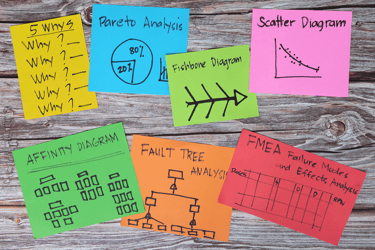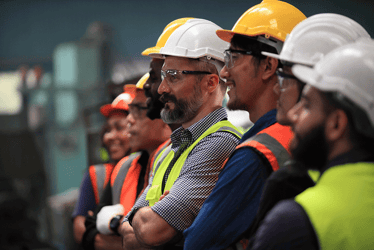The Packaging Industry's Sustainability Challenge: Why ERP Systems Are Essential for Success A straightforward guide to navigating sustainability regulations across folding carton, flexible...
Packaging sustainability: How your ERP can help you reach your goals
Your Enterprise Resource Planning (ERP) or Management Information System (MIS) is a valuable tool in helping you achieve, track, and report on your sustainability goals.
In the packaging industry, sustainable companies are profitable companies - sustainability and profitability go hand in hand. But how can you get there? How can your sustainability goals allow you to reduce the Cost of Goods Sold (COGS) and increase profits?
This blog discusses how your packaging business’ ERP can help embed sustainability into your company's DNA. With advanced features, your ERP will help you establish, track, and report on your sustainability goals, making your business more profitable and efficient.
Contents
- Sustainability as a driving force for profitability
- Navigating Packaging Sustainability: The 3 P's Framework
- Six reasons why you need a packaging sustainability policy
- Start here: 3 simple steps to embed sustainability deeper into your organization.
- Make the most out of your packaging ERP
- Key benefits of a purpose-built solution to drive sustainability and profitability
Sustainability as a driving force for profitability
Sustainability isn't just a trend; it's becoming a business necessity. According to IBM's "Beyond checking the box: How to create business value with embedded sustainability," a survey of 5,000 executives across 22 industries and countries reported that sustainability is now a top priority for businesses worldwide.
Key findings reveal that:
However, there's a gap between sustainability reporting and innovation spending, with reporting often outweighing innovation investment by 43%.
Yet, companies embedding sustainability into their core operations are reaping significant benefits:
- 16%
higher revenue growth. - 52%
more likely to outperform peers on profitability. - 56%
more likely to attract top talent.
IBM's report sends a clear message: businesses that embed sustainability into their DNA become more profitable. Even more, there is a massive need for reporting and data tools to accurately report sustainability efforts to internal and external stakeholders. Your packaging ERP is valuable because it will allow you to collect data, create reports, and track progress and goals.
Navigating Packaging Sustainability: The 3 P's Framework
Sustainability requires a comprehensive approach encompassing three pillars: planet, profit, and people. These elements are interconnected and indispensable for achieving sustainable success in the packaging business.
Planet: Acknowledging and mitigating your company's environmental impact is crucial. Whether through energy-efficient operations, waste reduction strategies, or sustainable sourcing along the supply chain, prioritizing the planet is essential for long-term sustainability.
Profit: Sustainability initiatives must align with profitability. While there's a common misconception that sustainability and profit are at odds, as the IBM report states, they can go hand in hand. In the packaging industry, sustainable practices can lead to cost savings, operational efficiencies, and enhanced brand reputation, all contributing to long-term profitability.
People: Fostering a culture of sustainability requires buy-in from all parties involved, from employees to suppliers and customers. Internally, educating and empowering employees to embrace sustainable practices can drive innovation and efficiency. Externally, transparent communication about sustainability efforts builds trust and loyalty among customers and investors.
Six reasons why you need a packaging sustainability policy
- Reduce Energy Usage and Waste: Leveraging your ERP system can open opportunities to optimize energy usage and reduce waste. Every aspect can be scrutinized and improved, from equipment efficiency to resource utilization, leading to significant cost savings and environmental benefits.
- Expand Customer Base: Today's consumers are increasingly conscious of sustainability practices and expect companies to align with their values. Businesses can attract and retain customers who prioritize environmental responsibility by demonstrating a commitment to sustainability through detailed policies and practices.
- Attract Investors and Talent: Sustainable companies are more attractive to investors and tend to attract top talent. Providing tangible data on sustainability efforts enhances investor confidence and signals to prospective employees that the company is forward-thinking and values-driven.
- Position as a Market Leader: Recognizing sustainability efforts can elevate a company's reputation and position it as a leader in its industry, including indices like the Dow Jones Sustainability Indices (DJSI), which attract investors and enhance brand credibility and market competitiveness.
- Increased Resilience: Implementing a packaging sustainability policy helps businesses future-proof themselves against tighter regulations and evolving consumer expectations. By proactively addressing sustainability concerns, companies can mitigate risks associated with regulatory changes and market shifts.
- Engagement Opportunities: Developing a sustainability policy provides a platform for engaging internal and external stakeholders. By involving employees, suppliers, and customers in sustainability initiatives, businesses can foster a sense of shared purpose and strengthen relationships across the value chain.
Start here: 3 simple steps to embed sustainability deeper into your organization.
As detailed above, sustainability shouldn't just be a project or a checkbox. Embedding sustainability to your packaging operation's core will positively impact your business. But to get there, you need concrete actions and the ability to report and act on them. To embed sustainability deeper into your organization, consider the following three simple yet impactful steps:
- Measure Current Activities: If it can't be measured, it can't be improved! Leveraging your ERP system is an excellent starting point. From machine uptime to material usage and waste generation, your packaging ERP software can provide valuable insights collected from real-time data into current practices.
- Set Clear Goals: Once you've assessed your current activities, the next step is to establish clear and achievable packaging sustainability goals. Engage stakeholders across the organization in this process. Setting specific, measurable, and time-bound goals ensures accountability and provides a roadmap for action. Whether reducing waste by a certain percentage or improving energy efficiency, articulate your goals in a way that inspires and motivates the entire organization to work towards a common purpose
- Monitor, Report, and Review: Implementing sustainability goals is the first step. Monitoring and reporting are essential to ensure progress and course correction as needed. The IBM survey states that only 31% of organizations are incorporating sustainability data and insights into operational improvements to a great extent, and a mere 14% do so with innovation initiatives. Establish regular meetings, both monthly and quarterly, to analyze performance against set goals. Utilize the data collected from your ERP system to track progress and identify areas where adjustments may be necessary. By regularly evaluating the impact of sustainability policies and initiatives, you can make informed decisions and demonstrate tangible progress to stakeholders
Make the most out of your packaging ERP
Here is how end-to-end packaging ERP software can help with packaging sustainability, reduce COGS, and increase revenue:
- Estimating: Advanced, state-of-the-art ERPs utilize advanced AI capabilities to revolutionize estimating processes. They analyze real-time and historical data alongside market trends and select appropriate materials tailored to specific packaging requirements. Packaging-specific ERPs minimize waste and promote sustainability by considering factors like durability, recyclability, and environmental impact. Additionally, packaging ERPs facilitate lightweighting initiatives by recommending materials that maintain product integrity while reducing overall packaging weight. Continuous learning algorithms ensure that estimating processes evolve, optimizing sustainability goals with each iteration.
- Scheduling: Efficient scheduling tools within your packaging business’ ERP are designed to maximize production efficiency while minimizing environmental impact. By optimizing job sequencing and minimizing changeovers, these tools enable running back-to-back jobs, reducing downtime and resource consumption. Furthermore, they analyze production requirements and select the most environmentally friendly print processes, such as digital or flexographic printing, based on material usage and energy consumption. Through proactive scheduling, your packaging ERP helps minimize waste and improve overall sustainability performance.
- Procurement: Integration between estimating, scheduling, and procurement modules ensures accurate forecasting of material needs within your packaging ERP system. The ERP accurately predicts future material requirements by analyzing historical usage patterns and real-time production schedules. This proactive approach to procurement prevents overstocking and stockouts, reducing excess inventory and waste. Additionally, it enables strategic sourcing decisions by considering factors like supplier sustainability practices and material sourcing locations.
- Shop floor automation: Your packaging ERP's features streamline production processes and minimize waste generation. Utilizing Direct Machine Interface (DMI) technology ensures accurate run lengths by synchronizing production data with machine settings, minimizing material waste due to overruns or underruns. Furthermore, it optimizes production workflows, reducing idle time and maximizing machine capacity and utilization. By automating repetitive tasks and optimizing production processes, your packaging ERP improves overall efficiency and reduces environmental impact.
- Reporting: Real-time reporting capabilities within your ERP provide valuable insights into sustainability performance and enable proactive decision-making. Automated triggers identify exceptions to sustainability goals, such as excessive material waste or energy consumption, alerting management for immediate action. Moreover, the ERP generates comprehensive reports that measure the environmental impact of production activities, allowing for continuous improvement initiatives. By facilitating data-driven decision-making and promoting transparency, your packaging ERP fosters a culture of sustainability within your organization and strengthens relationships with stakeholders.
Key benefits of a purpose-built solution to drive sustainability and profitability
Radius is an ERP software solution created by packaging converters for converters. It is purpose-built for the folding carton, labels, and flexible packaging industries. As an out-of-the-box business efficiency solution, it provides packaging manufacturers and converters with industry-specific estimating, scheduling, inventory management and planning, and shop floor information collection capabilities.
We can be your trusted partner in the sustainability journey. Whether you are just getting started or need to take it to the next level, our 30+ years of experience in the packaging industry make us the ideal partner to help you reach your goals.




